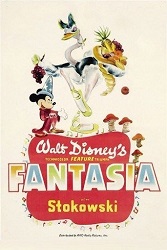Review of 'Fantasia'
 “Fantasia” is a milestone in film animation as it seeks to visualise classical music. Brought to the big screen by Disney animators “Fantasia” was originally released in a “road show” format to a small number of theatres that had to be fitted out with the technology it used (not only colour but multi-channel sound). It was treated very much like a classical music performance with a programme, assigned seats and an idea of updating the programme periodically over time with new segments. This was never to be and the film, released early in the second world war, was not initially received with open arms to the disappointment of Walt Disney who was very proud of what had been achieved. As the years have gone on it is now recognised as a ground-breaking piece of cinema that has never really been topped.
“Fantasia” is a milestone in film animation as it seeks to visualise classical music. Brought to the big screen by Disney animators “Fantasia” was originally released in a “road show” format to a small number of theatres that had to be fitted out with the technology it used (not only colour but multi-channel sound). It was treated very much like a classical music performance with a programme, assigned seats and an idea of updating the programme periodically over time with new segments. This was never to be and the film, released early in the second world war, was not initially received with open arms to the disappointment of Walt Disney who was very proud of what had been achieved. As the years have gone on it is now recognised as a ground-breaking piece of cinema that has never really been topped.
The film consists of eight short segments with Leopold Stokowski conducting the orchestra. Seven of the somewhat edited pieces of classical music are performed by the Philadelphia Orchestra. The master of ceremonies is Deems Taylor who provides an introduction to each piece giving the audience an idea of what to expect and look out for. Each of the segments features dramatically different, and often experimental, styles of animation:
- Toccata and Fugue in D Minor (Johann Sebastian Bach) - This is perhaps the most experimental piece with the animation featuring colours and shapes often reminiscent of violin bows.
- The Nutcracker Suite (Pyotr Ilyich Tchaikovsky) - A Disney-esque piece with dancing mushrooms, goldfish and thistles.
- The Sorcerer's Apprentice (Paul Dukas) - Likely the most recognisable piece from the film, featuring Mickey Mouse as the sorcerer's apprentice who borrows his master's magical hat to use magic to complete his chore of bringing water in from the well…with disastrous results. This is really the only piece that has an actual story.
- Rite of Spring (Igor Stravinsky) - Featuring animation showing the rise of life on earth beginning with single-celled organisms and ending with the fall of the dinosaurs.
- The Pastoral Symphony (Ludwig van Beethoven) - This animation is set in Greek mythology with dancing centaurs and various gods including a very drunk Bacchus.
- Dance of the Hours (Amilcare Ponchielli) - Another silly piece featuring dancing hippos, alligators, and ostriches performing ballet moves with segments for each part of the day…
- Night on Bald Mountain and Ave Maria (Modest Mussorgsky and Franz Schubert respectively) - Beginning with the magnificent “Night on Bald Mountain” featuring a dark god rising from the top of a mountain and bringing back the souls of the dead only to throw them into the abyss. The piece transitions into the spiritual “Ave Maria” following pilgrims carrying lights through a forest.
Though there is a lot of the familiar Disney animation here it is used in different and artistic ways to fit the the music. Even the Mickey here is not quite the gentle, innocent we are familiar with as he hacks a living broomstick to pieces. The animators have let their minds take flight and refusing to let common interpretation cloud their minds (“The Nutcracker Suite” is definitely not about a nutcracker here). The animation is top notch and whimsical to the extreme, easing into the music and not afraid to linger which may bore many viewers (particularly at a total run time of more than two hours…though with an “interval” in the road show version) but I found it fascinating.
An amazing piece of animation that still astonishes today. Though some may be frequently bored, “Fantasia” is a wonderful, unique merging of the moving picture and music for purely artistic reasons - This is a work of love and it shows.
Rating: “Nearly perfect, but not quite”
Review Date: 2020-03-22
Studio: Walt Disney Productions
Year: 1940
Length: 125 minutes
Genre: Animation
https://www.imdb.com/title/tt0032455/